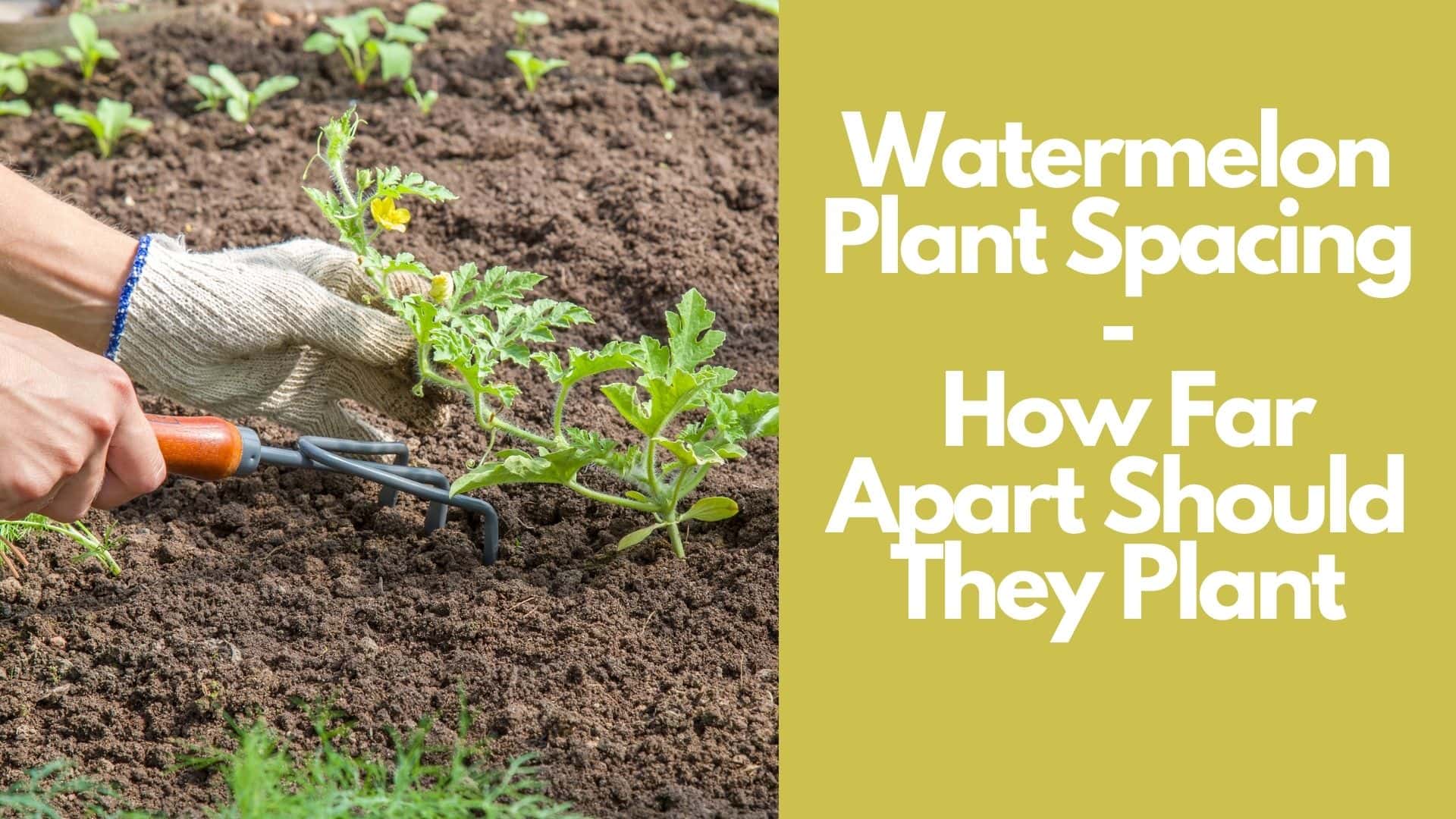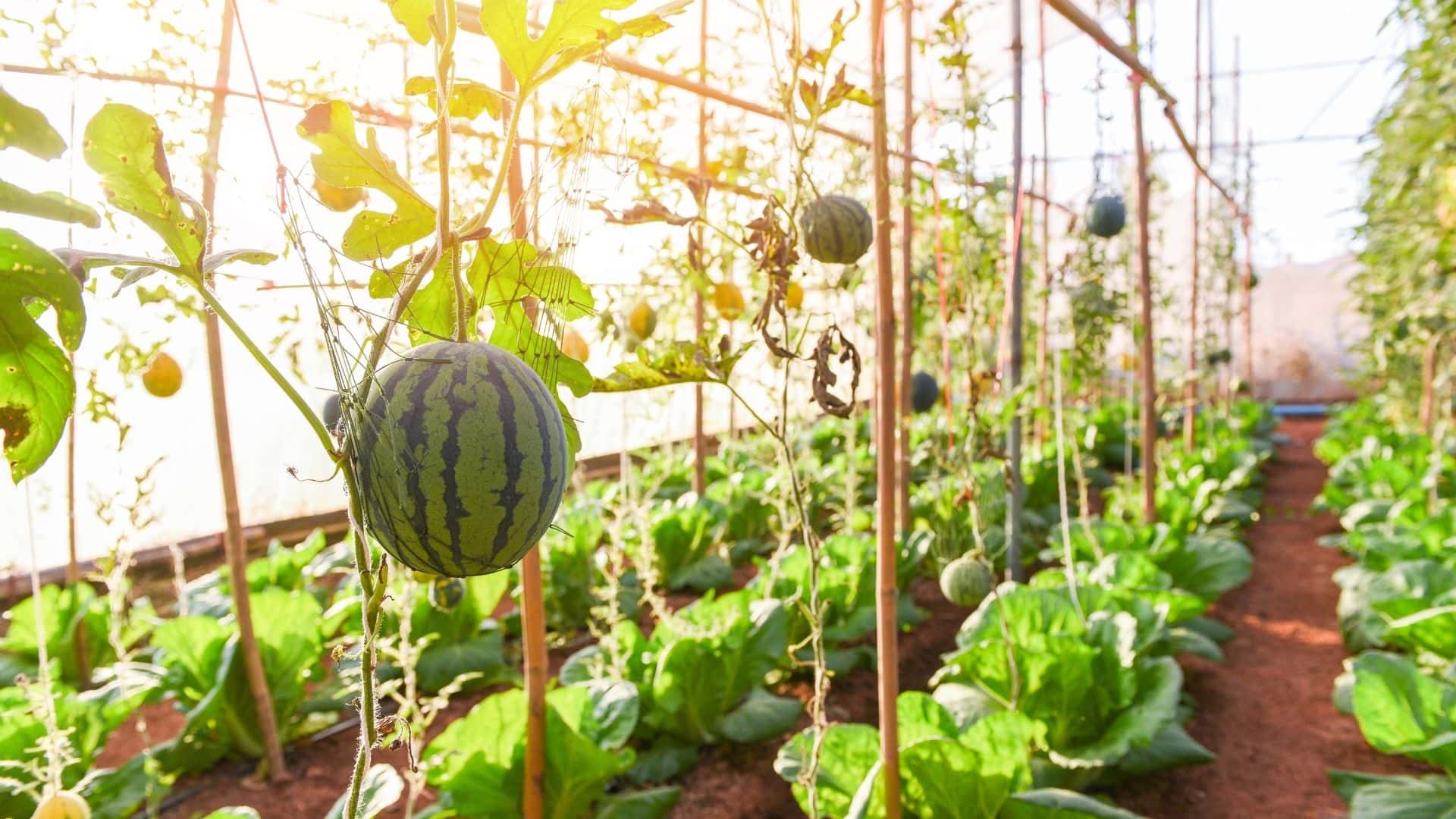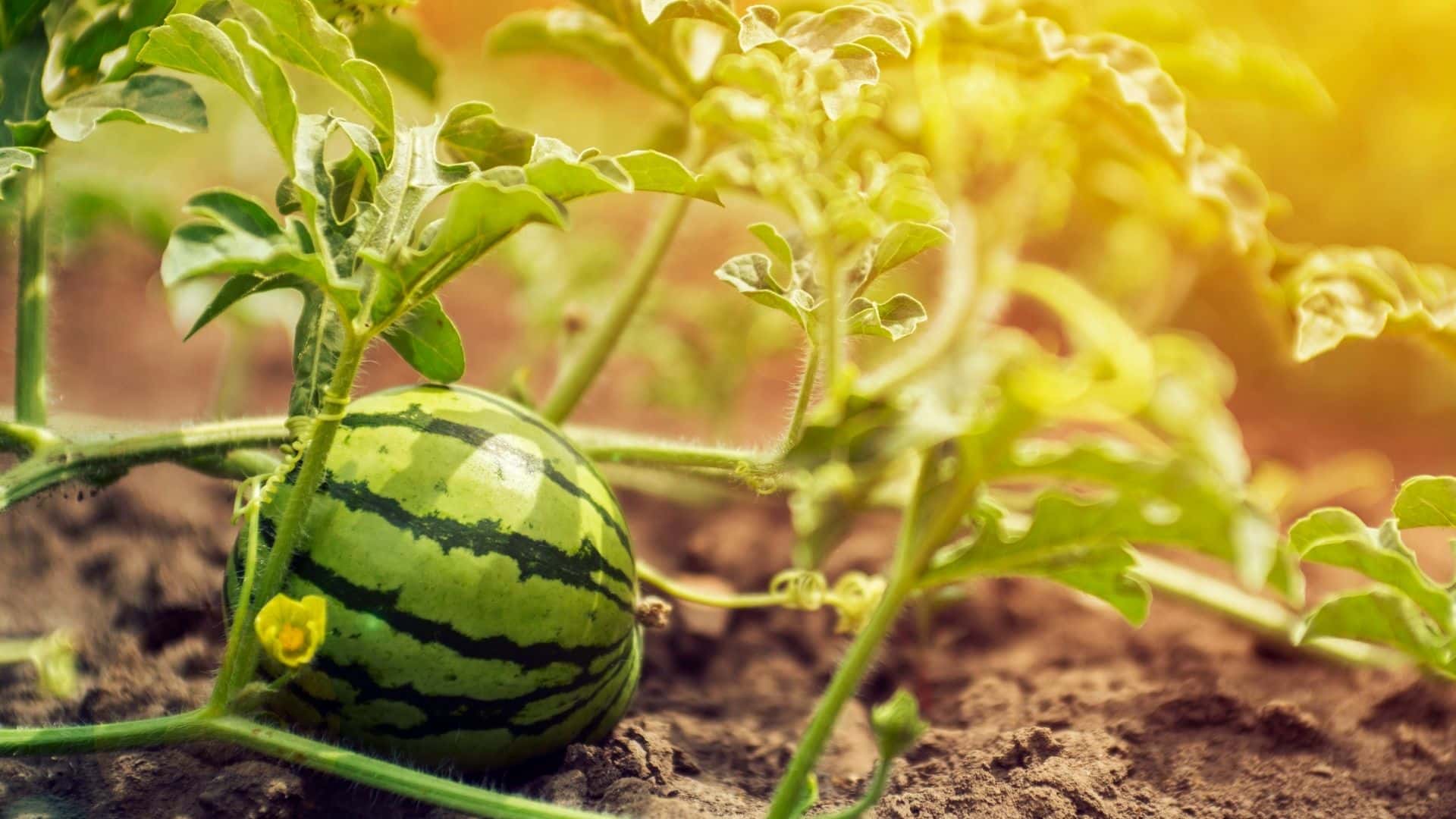Enjoying a juicy watermelon slice is a must-do summer. However, if you’ve always bought your watermelons at the store, you’re losing out on a lot of the best flavors there are. Anyone who truly loves watermelon should grow their own and let them ripen in the sun, they’ll taste better, and you’ll be able to eat one right from the garden to the table. Melons, which are native to Africa, need a long growing season and warm temperatures to thrive. A sunny location in your yard and a few seeds are all you need to get started.
For best production, the watermelon necessitates a variety of circumstances, including proper watermelon plant spacing.
Most gardeners are aware of the need for correct plant spacing, but many don’t put it into practice. This looks wasteful, and we can’t help but be swayed by the belief that planting more will yield more produce. By reading this guide, you will be able to know Watermelon Plant Spacing: How Far Apart Should They Plant.

Let’s start,
Since watermelon itself and the length of the vine take up so much space, the plants should be spaced far apart to allow for this. It is important to know how much space they need to grow well in the garden.
How do determine the correct spacing for watermelon plants?
A plan of action should be drawn out as soon as you have a general concept of what you want to plant in your garden and the amount of space that you have available. When comes to planting watermelons, there are numerous options in terms of proper plant spacing.
You may avoid confusion by reading the instructions on the back of the seed packet or the tags that come with any starting plants you purchase, though.
Why it is important to have space between watermelon plants?
There are various reasons that affect the spacing between watermelon plants. Below are some of the most important ones for your attention.
1. How does spacing important for the plant to get nutrients?
Nutrients are necessary for the growth and development of watermelon plants. As we all know, these nutrients come from the sun, soil, and whatever amendments and fertilizers we put into the soil over the growing season.
Due to competition for nutrients and sunlight, plants that lack these resources will not be as healthy as those that have all that they require. Their roots will also have to compete for nutrients and water, not to mention space.
Watermelon plants that are too sparse can also be problematic. If your plants are appropriately placed, the shade they provide can impede the growth of weeds and keep the soil moist, but only if they’re not too close together.
2. How does spacing important to control weeds?
Healthy watermelon plants necessitate effective weed control. Weeds grow more quickly when plants are too close together, which makes it difficult to remove them.
3. How does spacing important to retain moisture?
If you grow watermelon plants so closely, they dry quickly because all plants are competing for the soil’s moisture. To keep the soil moist, the garden has to be watered more frequently. Rain or irrigation water falling from above soaks the leaves, yet it may not make it to the ground below. Drought-stressed roots and soggy leaves make plants more susceptible to disease. So, spacing is more important to retain moisture in the watermelon garden.
4. How does spacing important to control pests and diseases?
Watermelon plant spacing has a dual effect on disease prevention. It lowers the spread of disease and strengthens the immune system of the plants. Plants that grow too close together are more susceptible to illness because it is easier for disease to move from one plant to another.
In addition to reducing air circulation, overcrowding is a risk factor for disease. This increases the risk of your plants becoming infected.
5. How does spacing important to improve yield?
In addition to the reasons given above, the most important one for spacing watermelon plants is to improve the yield. Actually, the watermelon plants that are properly spaced helps to yield more. And you’ll save time, effort, and money by reducing the number of plants you have.
How much space do watermelon plants need to grow?
Keep in mind that watermelons grow on long vines, so the distance between them will be substantial. If you’re planning on growing watermelon, you’ll need to pay attention to the variety. For little bushing type watermelons, allow around 3 feet in distance, or up to 10 feet for the largest watermelons.
Three seeds should be planted 1 inch deep in hills that are 4 feet apart and 6 feet between rows for typical varieties of watermelon.
Loams that are well-drained but somewhat acidic are ideal for growing watermelons. Sandy loams warm faster in the spring because of this. Also, sandy soil is ideal for watermelon plants since it allows for deep root development.
Temperatures should be at least 65 degrees Fahrenheit before planting these heat-loving plants. To keep the soil warm and moist, consider using black plastic mulch, floating row covers, or hot caps.
When the seedlings have two or three leaves, thin them out. The space around the melon should be kept clear of weeds and water if there is a lengthy period of dry weather. A lengthy taproot means that watermelons don’t need a lot of extra water, but they do well when given a lot of water, especially when they’re fruiting.
How to grow watermelon plants with spacing in a small garden?

Growing melons vertically expands the range of options available in the garden. Melons can be grown in medium to small-sized gardens thanks to this space-saving method. Melons can also be grown in a smaller area by planting numerous rows about four feet apart.
A sunny fence line can become a prolific melon patch if you have a privacy fence around your home. The trellis can also be used to form an external wall to the patio or deck area by planting the melon plants in a small bed beside the patio.
Large containers like half whiskey barrels, together with trellis material can be used by gardeners in apartments, townhouses, or gardens with limited space to grow their own produce. Instead of garden soil, use a high-quality potting mix in the container and check that it drains effectively.
Unlike their garden-dwelling relatives, container-grown melons will need more frequent watering to avoid stress and a lot of sunlight in order to thrive. As a result, they’ll need to be fed more frequently because their root zone is smaller.
Stakes can be used to hold the two ends of a 16-foot livestock panel in place on the ground while being bent into an arch shape. You can stroll under the arch. Add some color and interest to your yard or garden by planting a melon on each side of the path you take.
Take a look around your garden and see what you can come up with to grow melons more efficiently. The best place to start is with your favorite kinds, but don’t be afraid to try out new ones to see which ones work best for you and what spacing and cultural approaches work best in your garden.
Best watermelon varieties for small spaces
If you’re working with a limited amount of area, consider using watermelons that grow on short, bushy vines.
1. Bush Charleston Gray
There is an abundance of sugar. With the exception of the smaller size of the fruit and the shorter vine, this fruit is similar to Charleston Gray in appearance. Dark red flesh with delicate texture is contained within a gray-green rind. Small gardens will benefit from this. Open-pollinated.
2. Bush Sugar Baby
The red flesh is juicy and delicious. These small rounded fruits have dark green rinds. The vine only spreads 3 to 3 1/2 feet in length.
3. Bush Jubilee
Small, oblong fruit that grows to be 24 inches long. The rind is light green with dark green lines. The flesh is brilliant crimson and has a firm firmness. It only spreads 3 to 5 feet in diameter.
Best watermelon varieties for long spaces
These watermelon varieties are suitable for gardeners who have long space to grow.
1. Crimson Sweet
Fruit that is large and slightly elongated, measuring up to 12 inches in length. The rind is thick and hard, with light green and darker green stripes. The flesh is bright red in color and has a delicate texture.
2. King of Heart
The fruit is oval in shape, with a thick green rind and medium green stripes. The flesh is a bright red color with a medium texture.
3. Calsweet
This sweet fruit is large and oblong, reaching approximately 17 inches in length. The rind is light green with dark green stripes, and the flesh is bright red color.
4. Charleston Gray
Excellent flavor with a sharp finish. Large, cylindrical fruit that can grow up to 24 inches in length. The rind is a light greenish-gray color, with red flesh beneath it.
5. Sugar Baby
It is 6 to 8 inches long fruit. The thick, dark green rind darkens to the point of being almost black. Bright red-orange flesh with a fine texture. Excellent for use in a backyard garden.
Watch how to grow watermelons in the garden | Complete Guide Video
Top 5 FAQs & answers related to watermelon plant spacing: how far apart should they plant
How far do the roots of the watermelon plant spread?
A watermelon root’s hole and mound can grow to a depth of 8 to 10 inches or more, storing water and nutrients.
Is it possible to grow watermelon in pots?
Yes, watermelon can be grown in pots. The best way to ensure your success is to follow a few simple rules. Watermelons are fun to grow in pots, but adequate care is necessary.
How long does it take to grow watermelon?
It takes about 80 to 90 days from seed sowing to produce a full-size watermelon, depending on the variety. Sugar Baby, a little watermelon, can ripen in as little as 70 days.
What companion plants can grow with watermelons?
Peas, pole beans, bush beans, onions, leeks, chives, and garlic are all good companions for melons in the yard. Vegetables like cabbage, broccoli, cauliflower, Brussels sprouts, and okra grow well with melons in the garden.
Is there a way to keep watermelons from dangling?
Keeping the watermelon off the ground as it grows and develops is another protective action you may take. Protect the fruit from the ground by using a cage, plastic mulch, pegs, straw mulch, or other material. The fruit can even be allowed to ripen on a wooden board.
Conclusion
By reading this guide, I hope you got the full idea of Watermelon Plant Spacing: How Far Apart Should They Plant.
Please share this Watermelon Plant Spacing: How Far Apart Should They Plant with your friends and do a comment below about your feedback.
We will meet you on next article.
Until you can read, Do Strawberries Ripen After Picking: A – Z Guide
